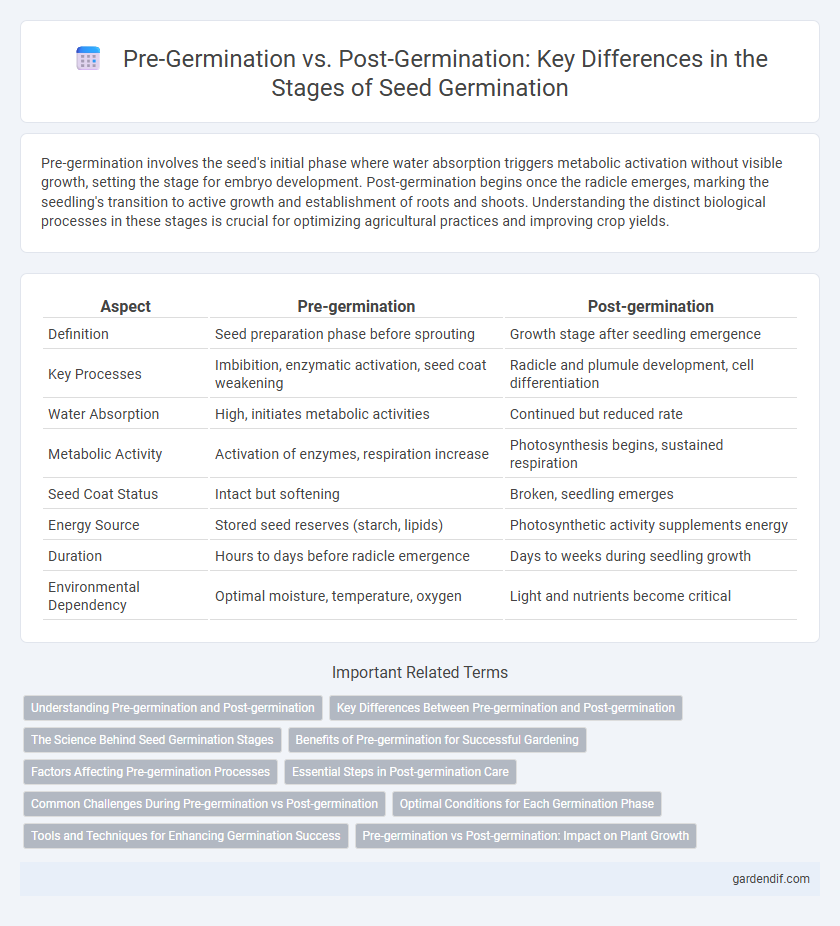
Pre-germination vs Post-germination Illustration
Pre-germination involves the seed's initial phase where water absorption triggers metabolic activation without visible growth, setting the stage for embryo development. Post-germination begins once the radicle emerges, marking the seedling's transition to active growth and establishment of roots and shoots. Understanding the distinct biological processes in these stages is crucial for optimizing agricultural practices and improving crop yields.
Table of Comparison
| Aspect | Pre-germination | Post-germination |
|---|---|---|
| Definition | Seed preparation phase before sprouting | Growth stage after seedling emergence |
| Key Processes | Imbibition, enzymatic activation, seed coat weakening | Radicle and plumule development, cell differentiation |
| Water Absorption | High, initiates metabolic activities | Continued but reduced rate |
| Metabolic Activity | Activation of enzymes, respiration increase | Photosynthesis begins, sustained respiration |
| Seed Coat Status | Intact but softening | Broken, seedling emerges |
| Energy Source | Stored seed reserves (starch, lipids) | Photosynthetic activity supplements energy |
| Duration | Hours to days before radicle emergence | Days to weeks during seedling growth |
| Environmental Dependency | Optimal moisture, temperature, oxygen | Light and nutrients become critical |
Understanding Pre-germination and Post-germination
Pre-germination involves conditions and treatments that prepare seeds for successful sprouting, such as imbibition, scarification, and stratification, which enhance seed water uptake and metabolic activation. Post-germination encompasses the initial growth stages after radicle emergence, including seedling development, cotyledon expansion, and root establishment, critical for nutrient absorption and photosynthesis initiation. Understanding both phases is essential for optimizing crop yield and ensuring robust plant development through targeted agricultural practices.
Key Differences Between Pre-germination and Post-germination
Pre-germination involves seed hydration, enzymatic activation, and metabolic processes that prepare the seed for growth, whereas post-germination encompasses radicle emergence, seedling development, and establishment of photosynthetic activity. Key differences include physiological states, with pre-germination focusing on biochemical changes within the seed coat and embryo, while post-germination centers on morphological growth and root-shoot differentiation. Environmental factors influencing pre-germination often involve moisture and temperature, whereas light exposure and nutrient availability critically impact post-germination stages.
The Science Behind Seed Germination Stages
Pre-germination involves physiological and biochemical changes such as water imbibition, enzyme activation, and metabolic pathway initiation essential for seed viability. Post-germination marks the emergence of the radicle and subsequent seedling growth, driven by cell division and elongation regulated by hormones like gibberellins and auxins. Understanding these stages reveals critical factors influencing seed dormancy, vigor, and successful plant development.
Benefits of Pre-germination for Successful Gardening
Pre-germination enhances seedling vigor by ensuring consistent moisture and temperature conditions, leading to higher germination rates and uniform plant growth. It reduces the risk of seedling diseases and minimizes the time required for seed emergence, thereby accelerating crop establishment. By enabling early root development, pre-germination improves nutrient uptake efficiency and increases the chances of successful transplanting.
Factors Affecting Pre-germination Processes
Pre-germination processes are primarily influenced by factors such as seed moisture content, temperature, oxygen availability, and light exposure, which collectively determine the seed's physiological readiness to initiate germination. Seed dormancy mechanisms, including physical and physiological barriers, also play a critical role in regulating water uptake and enzymatic activity before germination starts. Understanding these factors helps optimize conditions for seed imbibition, enzymatic activation, and embryo growth during the pre-germination phase.
Essential Steps in Post-germination Care
Post-germination care involves essential steps such as maintaining consistent moisture levels, providing adequate light for photosynthesis, and ensuring nutrient-rich soil to support seedling development. Monitoring temperature and protecting young plants from pests and diseases are critical to enhance survival rates. Proper thinning and timely transplanting further optimize growth conditions and promote healthy root establishment.
Common Challenges During Pre-germination vs Post-germination
Common challenges during pre-germination include seed dormancy, inadequate moisture, and poor temperature conditions that inhibit radicle emergence. Post-germination challenges often involve seedling diseases, nutrient deficiencies, and environmental stressors such as drought or excessive light, which affect seedling growth and survival. Managing these factors through proper seed treatment and optimal growing conditions enhances successful plant establishment.
Optimal Conditions for Each Germination Phase
Pre-germination requires optimal moisture levels, consistent warmth between 20-30degC, and adequate oxygen to activate enzymatic processes and initiate seed metabolic activity. Post-germination demands increased light exposure and continued moisture to support radicle and plumule growth, with temperatures slightly favoring the specific plant species' development phase. Maintaining controlled humidity and soil aeration during both phases ensures successful transition from seed dormancy to seedling establishment.
Tools and Techniques for Enhancing Germination Success
Pre-germination techniques such as seed priming, scarification, and stratification improve water uptake and break dormancy by altering seed coat permeability. Post-germination tools include controlled environment chambers and hydroponic systems that optimize light, moisture, and temperature to support seedling development. Advanced methods like laser treatment and biopriming with beneficial microbes enhance both germination rate and early seedling vigor.
Pre-germination vs Post-germination: Impact on Plant Growth
Pre-germination processes, including seed imbibition and enzyme activation, establish crucial cellular functions that influence subsequent plant development. Post-germination growth depends on the effective transition from seed reserves to autotrophic nutrition, impacting root and shoot elongation rates. Differences between pre-germination vigor and post-germination adaptation significantly determine overall plant growth performance and biomass accumulation.
Pre-germination vs Post-germination Infographic

 gardendif.com
gardendif.com